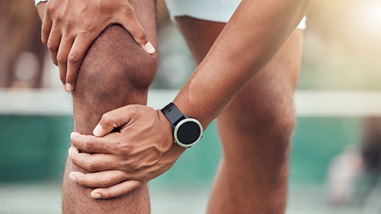
Common tennis-related injuries
Don’t let injury or poor form interfere with your love of tennis. We take a look at some of the most common tennis injuries experienced by professionals and enthusiasts alike, and consider what you can do to avoid injury. We seek advice from a consultant hand and wrist surgeon, who talks us through some of the available treatments for the injuries tennis players are prone to.
Not only can injury to your hand and wrist impact your ability to continue playing tennis, but it can also make carrying out everyday tasks and activities more challenging. This becomes a difficult cycle to escape from, as the more you use your wrist to perform everyday activities (such as typing or carrying out your usual household chores), the more pressure you place on your affected joint, preventing it from healing properly and interfering with your love of the sport.
The most common cause of damage to your wrist through tennis is overuse... This wear and tear can lead to extreme pain, swelling, inflammation, and stiffness.
What causes hand and wrist injuries in tennis?

The most common cause of damage to your wrist through tennis is overuse. The excessive wrist motion that occurs when you play tennis causes natural wear and tear, which happens when the cartilage (a strong, flexible, connective tissue that protects your joint from damage) breaks down. This exposes the bones surrounding your cartilage, causing them to rub together, which can make a grating or clicking sound.
This wear and tear can lead to extreme pain, swelling, inflammation, and stiffness. It can also be referred to as osteoarthritis. Rheumatoid arthritis is a different type of arthritis that can be present in your hand and wrist, causing pain and inflammation - but this is an autoimmune disease that happens when your body attacks its healthy cells by mistake.
Other common causes of damage to your hand and wrist are sporting injuries that occur while you're playing tennis, such as a direct blow to your wrist that shatters your bones while playing - also known as a fracture.
What are the symptoms of common tennis injuries?
Before knowing the most common tennis injuries, it helps to recognise symptoms of an injury (whether these are felt immediately after your injury, or days later). Key symptoms are:
- Injury or inflammation
- Pain, especially when putting pressure on your affected joint (tennis wrist pain is very common)
- An aching pain that persists, even after taking anti-inflammatory medication and resting as much as possible
- Swelling in your affected joint
- Stiffness
- Weakness
- Clicking or grating of your joint
ECU tendonitis can also make it difficult to grip objects because it weakens your wrist.

What are the most common injuries in tennis?
Consultant Hand and Wrist Surgeon Mr Andy Hacker from The Saxon Clinic shares his advice on the three most common tennis-related conditions.
ECU tendonitis can affect your tennis game
Your extensor carpi ulnaris (ECU) tendon can be found on the pinky side of your hand. When this is injured, explains Mr Hacker, it can become inflamed, severely affecting your tennis game.
"It is most commonly injured through sport that involves forceful wrist movements, such as tennis. In some cases, injury might cause your tendon to 'snap' around your ulna bone with certain wrist movements, particularly rotation. ECU tendonitis can also make it difficult to grip objects because it weakens your wrist."
Luckily the condition is very treatable through plenty of rest, taking anti-inflammatory medication such as ibuprofen and paracetamol and – If symptoms persist despite these options – you can have a local steroid injection. Also known as steroid injection therapy, this treatment involves injections of steroid medication (corticosteroid) into your painful tendon. This can effectively reduce pain and inflammation, and the effects can last anywhere from a few weeks to a few months. This form of pain relief may be recommended if you can't take oral anti-inflammatories for any reason.
De Quervain's tenosynovitis
De Quervain's tenosynovitis is a common tennis-related condition. It is the inflammation of two of the tendons that cross your wrist at the base of your thumb. These tendons usually glide smoothly through a tight soft tissue tunnel in your hand, but when they are inflamed, this movement becomes more restrained and causes pain when moving your wrist and thumb. Repetitive movements with your wrist and thumb, such as those performed during tennis, can cause this condition. Other symptoms of De Quervain's tenosynovitis include difficulty moving your wrist and thumb, a 'sticking' sensation in your thumb when trying to move it, and swelling near the base of your thumb.
"Treatment for this condition is largely the same as it is for ECU tendonitis, and it is as equally effective," explains Mr Hacker. "If steroid injection therapy and medication don't help resolve the problem, sometimes a small operation is required to release your tendon from the soft tissue tunnel. You might also need splinting before and after surgery."
Tennis elbow
Also known as lateral epicondylitis, tennis elbow is a type of elbow tendonitis that causes pain and aching on the bony part of the outside of your elbow. It's caused by repetitive stress to your elbow through overuse and persistent movement. Symptoms can include severe, achy pain over the outside of your elbow, an inability to fully straighten your arm and worsening pain with various activities, such as carrying heavy shopping.
Tennis elbow can be exceptionally painful and debilitating, but, like the conditions mentioned above, it is very treatable through a variety of effective treatment options. Treating tennis elbow involves steroid injection therapy, physiotherapy, and anti-inflammatory medication.
Preventing tennis injuries so you can keep playing
There are a few things you can do to try and minimise your risk of developing a tennis-related injury during a tennis game.
Always play with a fitted racket
Ensure that your tennis racket fits you. Is the grip size correct for your hand? Is your tennis racket strung to the correct tension? Your local tennis shop should be able to advise you on these factors when you're buying your racket.
It's all in your technique
Pay attention to your technique. Are you holding your tennis racket correctly? Are you hitting the tennis ball at the right time during your swing? Playing regularly and having lessons can help you master the perfect technique to protect you from injury.
Warmups are vital
Make sure to warm up and cool down each time you play and adjust your activities if you develop discomfort or pain. Your tennis coach will ensure you know how to warm up and cool down effectively, but this usually involves playing a first round or two with less impact than usual, and plenty of stretching.
Treat your injury as soon as possible
Some people become injured and continue to play through the pain and damage to their hand and wrist. Try not to leave it too late to get treated for your injury - as soon as you experience symptoms, start taking anti-inflammatory medication, and if the pain persists, seek advice from your doctor about whether you might need some physiotherapy or splinting to help you heal.

Physiotherapy for tennis injuries
Physiotherapy is a highly effective form of treatment for almost any sports-related injury. It can dramatically help improve your range of motion, strength, and flexibility. Your physiotherapist will work with you to build your physiotherapy plan - it will be entirely based on your individual needs with a key focus on getting you back playing tennis as soon as possible. So, no matter the injury or condition, rest assured you can try this to effectively manage your symptoms and recover quickly.
Hand therapy for tennis injuries
Our specialist teams of hand therapists are trained to the highest level to make custom made splints for many hand conditions, often caused tennis-related injuries. Here are some examples of when you may need a splint designed and fitted for you:
- To provide rest and support for healing tissues following injury or surgery
- To support painful joints
- To improve the movement in your hand, wrist or arm
- To help you use your hand, wrist or arm for function
Splinting might be enough to help you recover from conditions such as De Quervain's tenosynovitis, because it provides rest and support to your soft tissue.
To book in with one of our physiotherapists or hand specialists, or to find out which is right for you, give us a call today.
Tags
How do I book an appointment?
If you're concerned about symptoms you're experiencing or require further information on this subject, talk to a GP or see an expert consultant at your local Circle Hospital.